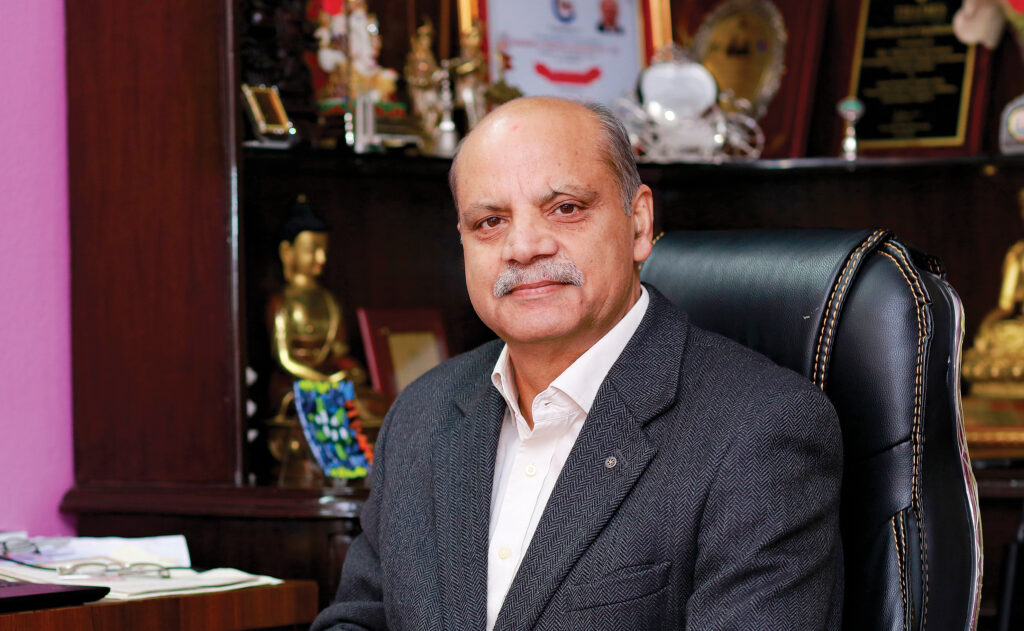 In its three decades of establishment, Dabur Nepal has set milestones in the corporate sector of Nepal. Be it sales & marketing, product development, or HR management, the subsidiary of the Indian multinational FMCG company Dabur Ltd, has always been at the forefront of its business. In April this year, the company struck a Rs 9.68 billion reinvestment deal with the Investment Board Nepal.
In its three decades of establishment, Dabur Nepal has set milestones in the corporate sector of Nepal. Be it sales & marketing, product development, or HR management, the subsidiary of the Indian multinational FMCG company Dabur Ltd, has always been at the forefront of its business. In April this year, the company struck a Rs 9.68 billion reinvestment deal with the Investment Board Nepal.
Abhaya Pd. Gorkhalee, Additional General Manager of Dabur Nepal, is with the company since 2007 and has worked in various roles and responsibilities related to marketing. In a conversation with the HRM, he talked about the three decades of Dabur Nepal, the company’s reinvestment plans, current challenges in the FMCG market, and changing landscape in the area of marketing, among other topics. Excerpts:
Dabur Nepal will complete its 31st year next month. What factors are behind the company’s growth since its inception in 1992?
The major factors behind Dabur Nepal’s growth since its establishment are professional management, quality products, consumer orientation, entrepreneurial spirit encouraging innovation and new product development, and the people first culture in the organization.
What are the major milestones in business for Dabur Nepal over the last three decades?
Dabur Nepal has been contributing to Nepal’s economy immensely. Over the years, Dabur Nepal’s business which started with export orientation has crossed an annual turnover of Rs 15 billion. The government of Nepal has recognized us as the highest exporter in the juice category for helping the country narrow down our trade deficit with India. Similarly, the government has also conferred Dabur Nepal as the Commercially Important Person (CIP).
More than 60 percent of Dabur Group’s juices requirement is supplied by Dabur Nepal. Our bio-resource division with the state-of-the-art greenhouse facilities in Banepa has played an important role to conserve precious and endangered medicinal plants.
Dabur Nepal is a market leader in most of the categories that it operates in Nepal including non-carbonated soft drinks (NSCD), GlucoseD, Chyawanprash, honey, toothpaste, hair oils, digestive tablets etc.
How is the company solidifying its market presence with the new line of consumer products?
We see it in a very structured manner as below:
- Strengthening the Core – Plugin SKU-gaps, varianting, premiumization, strengthening distribution and penetration, etc.
- Entering the Adjacencies – Plugging in Portfolio gaps
- Power Brand Approach – Leveraging the power brands
In late April, Dabur Nepal signed an MoU with the Investment Board Nepal (IBN) to invest an additional Rs 9.69 billion under its Capacity Enhancement and Diversification Project. What are the major objectives of the company’s project?
We have classified our additional investment plan into three buckets. First, expanding into new categories and new product lines. Second, capacity expansion and upgrading our production facilities. And the third is regular capex to maintain the current production lines.
How will the investment help to generate new jobs in the country?
It is a fundamental economic theory or the fact that any additional capital investment will create more jobs in any economy and we cannot be an exception to it.
Business activities have been affected by the ongoing economic slowdown. How the slowdown has affected the FMCG market?
The macroeconomic environment surely affects our business and the economic slowdown has softened our growth in the last couple of quarters despite our efforts to combat the downturn.
We could clearly see the downtrend in the market along with pressure on volume growth. However, the impact of an economic slowdown is relatively milder on FMCG business compared to other sectors.
Dabur Nepal is considered among the companies that give special attention to product marketing. What practices in marketing the company has its focus on to drive growth?
Marketing is always pivotal in any FMCG business. But marketing is not limited to advertising and communication, it starts with deep consumer insights that lead to successful product development following the fundamentals of the STP (Segmentation-Targeting-Positioning) approach followed by branding, advertising, and communications.
How do you observe the challenging landscape of marketing and advertising in Nepal over the years?
Any business or function would have its own challenges. But if you are asking me about the challenging landscape of marketing and advertising in Nepal, I am not so proud to tell you that we do not have any competent market research agencies that can give us very basic data & information on Retail Measurements like distribution (Numeric distribution /Weighted Distribution), Market Share trend (MS/SAH, etc.). Neither do we have any household penetration data nor any credible media data including TRP, GRPs or readership, circulation, and listenership data.
We face problems many times to take some bold steps or sometimes justifying our decisions due to a lack of such fundamental data. Imagine, we do not even have a single multinational advertising agency that could have helped us groom world-class creative resources in Nepal also helping the advertising fraternity to follow the best practices in the respective field.
How is Dabur Nepal utilizing social media and other digital mediums for promotional activities?
Since Facebook penetration is very high in Nepal, we are active in Facebook as well as other emerging digital platforms including Instagram, Tiktok, Youtube, Google Ads, digital banners in online portals, etc.
As we believe digital is the future, we can’t afford to be far away from it. So, we are very much there in digital space as we invest almost 20-25 percent of our total media investment in digital space.



